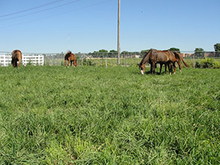Grass mixtures containing the following species are good for Midwest horse pastures.
-
Endophyte-free tall fescue
-
Perennial ryegrass
-
Kentucky bluegrass
-
Timothy
These species mixes will likely result in preferred, persistent and high yielding horse pastures.
Cool-season grasses are the basis of productive horse pastures in the Midwest. As selective grazers, horses can graze forage species shorter than other livestock. This grazing behavior can:
-
Limit the growth and survival of some forage species
-
Affect uniform use, yield and persistence of forage species, especially if horses repeatedly graze preferred species
We looked at horse preference, yield and species persistence of cool-season grass mixtures under horse grazing. Understanding these characteristics in grass pasture mixes can help you select an ideal grass pasture mix.
Testing grass mixtures
We grazed four adult horses on eight commercially marketed cool-season pasture mixes. All mixtures contained four to six cool-season perennial grass species (table 1).
We measured the species population density each spring and fall and the yield before each grazing. We took and dried subsamples of forage to determine dry matter content for yield.
Post grazing we visually assessed horse preference by the percent of forage removed on a scale of 0 (no grazing) to 100 (100 percent of vegetation removed).
Results
Horses preferred mixtures containing the following species (table 1):
-
Endophyte-free tall fescue
-
Perennial ryegrass
-
Kentucky bluegrass
-
Timothy
Horses had less preference for mixtures containing 30 percent or more orchardgrass. A more preferred mixture will result in more uniform grazing, which increases forage use and reduces maintenance (e.g. mowing).
Mixtures had similar forage yields that ranged from 2.7 to 3.2 tons per acre (table 1). After two years of grazing, populations of:
-
Orchardgrass and endophyte-free tall fescue increased from initial percentage of the mixtures
-
Kentucky bluegrass remained constant
-
Meadow fescue and perennial ryegrass had the greatest rate of decline (figure 1)
-
Orchardgrass became the dominant species, regardless of initial percentage in the mixture.
Recommendations
You should plant the following species in Midwest horse pastures.
-
Endophyte-free tall fescue
-
Perennial ryegrass
-
Kentucky bluegrass
-
Timothy
Over time, endophyte-free tall fescue and Kentucky bluegrass will likely dominate these mixtures.
Planting mixtures similar to Agassiz CHS #4 and La Crosse BLM #4 should result in high yielding, persistent and preferred grass horse pastures in the Midwest (table 1).
Table 1. Initial composition, forage yield (ton per acre) and preference (percent removal) of eight cool-season grass mixtures grazed by horses in Minnesota.
| Mixture | Species | Initial mixture composition (%) | Yield (tons/acre) | Preference (% removal) |
|---|---|---|---|---|
| Agassiz CHS #4 | Tall Fescue | 40 | 3.1 | 88 |
| Perennial Ryegrass | 30 | 3.1 | 88 | |
| KY Bluegrass | 15 | 3.1 | 88 | |
| Timothy | 15 | 3.1 | 88 | |
| Agassiz MN-G | Meadow Bromegrass | 30 | 3.2 | 45 |
| Orchardgrass | 30 | 3.2 | 45 | |
| Tall Fescue | 30 | 3.2 | 45 | |
| Perennial Ryegrass | 10 | 3.2 | 45 | |
| CR Heavy | KY Bluegrass | 45 | 2.7 | 46 |
| Orchardgrass | 35 | 2.7 | 46 | |
| Timothy | 20 | 2.7 | 46 | |
| Perennial Ryegrass | 10 | 2.7 | 46 | |
| CR Light | KY Bluegrass | 40 | 3.1 | 48 |
| Orchardgrass | 20 | 3.1 | 48 | |
| Crested Wheatgrass | 10 | 3.1 | 48 | |
| Meadow Bromegrass | 10 | 3.1 | 48 | |
| Perennial Ryegrass | 10 | 3.1 | 48 | |
| Timothy | 10 | 3.1 | 48 | |
| Dan Patch | KY Bluegrass | 40 | 3 | 59 |
| Smooth Bromegrass | 20 | 3 | 59 | |
| Perennial Ryegrass | 15 | 3 | 59 | |
| Orchardgrass | 15 | 3 | 59 | |
| Timothy | 10 | 3 | 59 | |
| La Crosse BLM #4 | Perennial Ryegrass | 30 | 2.8 | 91 |
| Annual Ryegrass | 20 | 2.8 | 91 | |
| Tall Fescue | 20 | 2.8 | 91 | |
| KY Bluegrass | 15 | 2.8 | 91 | |
| Timothy | 15 | 2.8 | 91 | |
| Marties | Timothy | 40 | 2.7 | 67 |
| Tall Fescue | 25 | 2.7 | 67 | |
| Orchardgrass | 20 | 2.7 | 67 | |
| KY Bluegrass | 10 | 2.7 | 67 | |
| Perennial Ryegrass | 5 | 2.7 | 67 | |
| Waconia Mix | KY Bluegrass | 35 | 3.1 | 63 |
Reviewed in 2021



